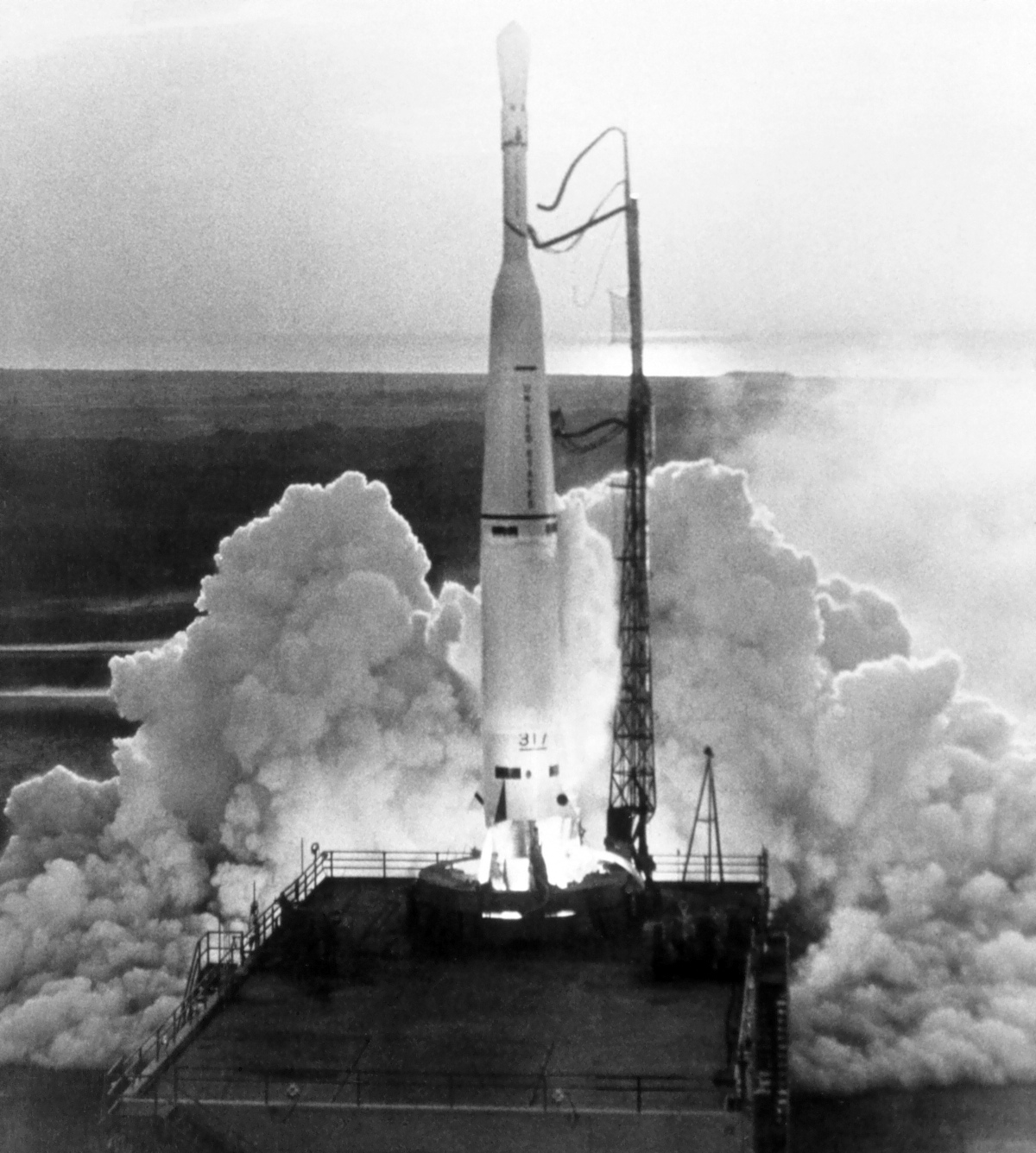
Thor Delta
In-activeMcDonnell Douglas (MDC)
May 13, 1960
Description
American orbital launch vehicle. Commercial name for the military's Thor-Delta.
Specifications
-
Stages
3 -
Length
31.0 m -
Diameter
2.44 m -
Fairing Diameter
2.44 m -
Launch Mass
54.0 T -
Thrust
667.0 kN
Family
-
Name
Thor Delta -
Family
― -
Variant
Delta -
Alias
― -
Full Name
Thor Delta
Payload Capacity
-
Launch Cost
$7270000 -
Low Earth Orbit
226.0 kg -
Geostationary Transfer
Orbit
― -
Direct Geostationary
― -
Sun-Synchronous Capacity
―
McDonnell Douglas
Commercial
None
MDCNone
Thor Delta | Tiros 6
McDonnell Douglas | United States of AmericaCape Canaveral SFS, FL, USA
Sept. 18, 1962, 8:53 a.m.
Thor Delta | Telstar 1
McDonnell Douglas | United States of AmericaCape Canaveral SFS, FL, USA
July 10, 1962, 8:35 a.m.
Thor Delta | Tiros 5
McDonnell Douglas | United States of AmericaCape Canaveral SFS, FL, USA
June 19, 1962, 12:19 p.m.
Thor Delta | Ariel 1
McDonnell Douglas | United States of AmericaCape Canaveral SFS, FL, USA
April 26, 1962, 6 p.m.
Thor Delta | OSO 1
McDonnell Douglas | United States of AmericaCape Canaveral SFS, FL, USA
March 7, 1962, 4:06 p.m.
Thor Delta | Tiros 4
McDonnell Douglas | United States of AmericaCape Canaveral SFS, FL, USA
Feb. 8, 1962, 12:43 p.m.
Thor Delta | Tiros 2
McDonnell Douglas | United States of AmericaCape Canaveral SFS, FL, USA
Nov. 23, 1960, 11:13 a.m.
Thor Delta | Echo 1
McDonnell Douglas | United States of AmericaCape Canaveral SFS, FL, USA
Aug. 12, 1960, 9:39 a.m.
Status: Launch Successful
Mission:
The Echo 1A spacecraft was a 30.48 m diameter balloon of mylar polyester film 0.0127 mm thick. The spacecraft was designed as a passive communications reflector for transcontinental and intercontinental telephone (voice), radio, and television signals. It had 107.9 MHz beacon transmitters for telemetry purposes. These transmitters were powered by five nickel-cadmium batteries that were charged by 70 solar cells mounted on the balloon. Because of the large area-to-mass ratio of the spacecraft, data for the calculation of atmospheric density and solar pressure could be acquired. The spacecraft was also used to evaluate the technical feasibility of satellite triangulation during the latter portion of its life. Echo 1 failed during the coast period after launch, as the attitude control jets on the second stage failed and the spacecraft did not achieve orbit. Echo 1A was a successful relaunch.
Elliptical OrbitThor Delta | Echo
McDonnell Douglas | United States of AmericaCape Canaveral SFS, FL, USA
May 13, 1960, 9:16 a.m.
Status: Launch Failure
Mission:
The Echo 1 spacecraft was a 30.48 m diameter balloon of mylar polyester film 0.0127 mm thick. The spacecraft was designed as a passive communications reflector for transcontinental and intercontinental telephone (voice), radio, and television signals. It had 107.9 MHz beacon transmitters for telemetry purposes. These transmitters were powered by five nickel-cadmium batteries that were charged by 70 solar cells mounted on the balloon. Because of the large area-to-mass ratio of the spacecraft, data for the calculation of atmospheric density and solar pressure could be acquired. The spacecraft was also used to evaluate the technical feasibility of satellite triangulation during the latter portion of its life. Echo 1 failed during the coast period after launch, as the attitude control jets on the second stage failed and the spacecraft did not achieve orbit. Echo 1A was a successful relaunch.
Elliptical OrbitLong March 12A
Demo Flight
Long March 12A Pad - Jiuquan Satellite Launch Center, People's Republic of ChinaFirst test launch of CASC/SAST’s Long March 12A rocket, with a dummy payload. The rocket’s 1st stage attempted to land on a landing pad about 300 km …
HANBIT-Nano
Spaceward
HANBIT Pad - Alcântara Space Center, Federative Republic of BrazilMaiden orbital launch attempt for the South Korean stratup Innospace and its HANBIT-Nano small launch vehicle. Onboard this flight are five small sat…
H3-22
Michibiki 5 (QZS-5)
Yoshinobu Launch Complex LP-2 - Tanegashima Space Center, JapanQZSS (Quasi Zenith Satellite System) is a Japanese satellite navigation system operating from inclined, elliptical geosynchronous orbits to achieve o…
Electron
The Wisdom God Guides (iQPS Launch 6)
Rocket Lab Launch Complex 1B - Rocket Lab Launch Complex 1, Mahia Peninsula, New ZealandSynthetic aperture radar Earth observation satellite for Japanese Earth imaging company iQPS.
New Shepard
NS-37
West Texas Suborbital Launch Site/ Corn Ranch - Corn Ranch, Van Horn, TX, USANS-37 is the 16th crewed flight for the New Shepard program and the 37th in the New Shepard program's history.

